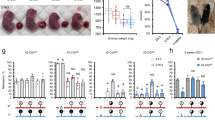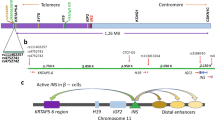Abstract
The callipyge (CLPG) phenotype (from καλι, “beautiful,” and πιγɛ, “buttocks”) described in sheep is an inherited muscular hypertrophy that is subject to an unusual parent-of-origin effect referred to as polar overdominance: only heterozygous individuals having inherited the CLPG mutation from their sire exhibit the muscular hypertrophy1. The callipyge (clpg) locus was mapped to a chromosome segment of approximately 400 kb (refs. 2–4), which was shown to contain four genes (DLK1, GTL2, PEG11 and MEG8) that are preferentially expressed in skeletal muscle and subject to parental imprinting in this tissue5,6,7,8,9. Here we describe the effect of the CLPG mutation on the expression of these four genes, and demonstrate that callipyge individuals have a unique expression profile that may account for the observed polar overdominance.
This is a preview of subscription content, access via your institution
Access options
Subscribe to this journal
Receive 12 print issues and online access
$209.00 per year
only $17.42 per issue
Buy this article
- Purchase on Springer Link
- Instant access to full article PDF
Prices may be subject to local taxes which are calculated during checkout


Similar content being viewed by others
References
Cockett, N.E. et al. Science 273, 236–238 (1996).
Shay, T. et al. Mamm. Genome 12, 141–149 (2001).
Segers, K. et al. Anim. Genet. 31, 352–359 (2001).
Berghmans, S. et al. Mamm. Genome 12, 183–185 (2001).
Charlier, C. et al. Genome Res. (in press).
Miyoshi, N. et al. Genes Cells 5, 211–220 (2000).
Schmidt, J.V. et al. Genes Dev. 14, 1997–2002 (2000).
Takada, S. et al. Curr. Biol. 10, 1135–1138 (2000).
Wylie, A.A. et al. Genome Res. 10, 1711–1718 (2000).
Acknowledgements
We thank A. Ferguson-Smith and M. Paulsen for discussions. This project was supported by grants from Fonds de la Recherche Fondamentale Collective (n° 2.4525.96), Crédit aux Chercheurs (n° 1.5.134.00) from the Fonds National de la Recherche Scientifique, Crédit à la Recherche from the University of Liège, the Utah Center of Excellence Program, the USDA/NRI Competitive Grants Program (USDA/NRICGP grants 94-04358, 96-35205 and 98-03455) and the Utah Agricultural Experiment Station.
Author information
Authors and Affiliations
Corresponding author
Rights and permissions
About this article
Cite this article
Charlier, C., Segers, K., Karim, L. et al. The callipyge mutation enhances the expression of coregulated imprinted genes in cis without affecting their imprinting status. Nat Genet 27, 367–369 (2001). https://doi.org/10.1038/86856
Received:
Accepted:
Issue Date:
DOI: https://doi.org/10.1038/86856
This article is cited by
-
Identification of genes directly responding to DLK1 signaling in Callipyge sheep
BMC Genomics (2018)
-
A Regulatory Circuitry Between Gria2, miR-409, and miR-495 Is Affected by ALS FUS Mutation in ESC-Derived Motor Neurons
Molecular Neurobiology (2018)
-
Hoxa5 undergoes dynamic DNA methylation and transcriptional repression in the adipose tissue of mice exposed to high-fat diet
International Journal of Obesity (2016)
-
Delta-like 1 homolog in Capra hircus: molecular characteristics, expression pattern and phylogeny
Molecular Biology Reports (2016)
-
Epigenetics: spotlight on type 2 diabetes and obesity
Journal of Endocrinological Investigation (2016)



